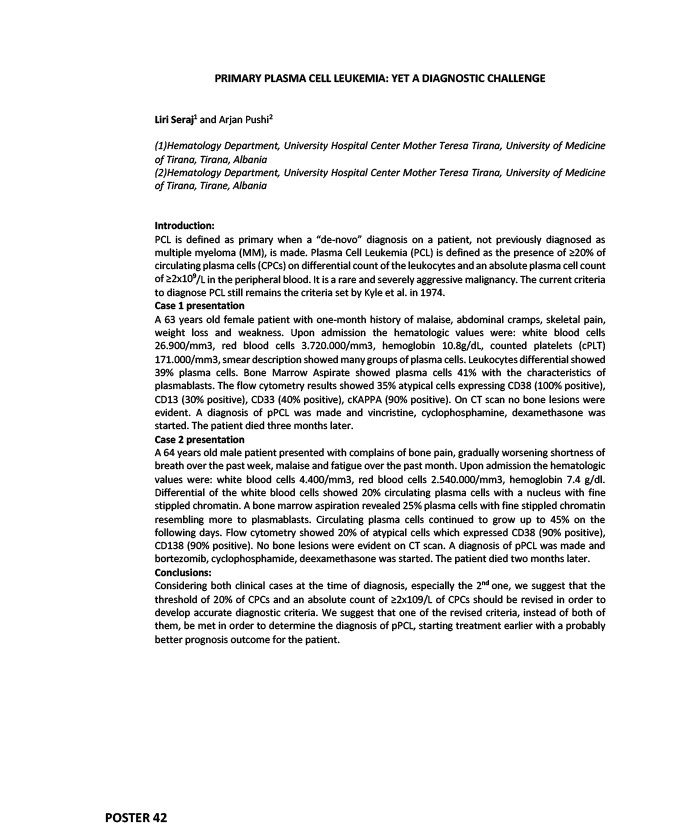
POSTER 42
PRIMARY PLASMA CELL LEUKEMIA: YET A DIAGNOSTIC CHALLENGE
Liri Seraj1 and Arjan Pushi2
(1)Hematology Department, University Hospital Center Mother Teresa Tirana, University of Medicine
of Tirana, Tirana, Albania
(2)Hematology Department, University Hospital Center Mother Teresa Tirana, University of Medicine
of Tirana, Tirane, Albania
Introduction:
PCL is defined as primary when a “de-novo” diagnosis on a patient, not previously diagnosed as
multiple myeloma (MM), is made. Plasma Cell Leukemia (PCL) is defined as the presence of ≥20% of
circulating plasma cells (CPCs) on differential count of the leukocytes and an absolute plasma cell count
of ≥2x109/L in the peripheral blood. It is a rare and severely aggressive malignancy. The current criteria
to diagnose PCL still remains the criteria set by Kyle et al. in 1974.
Case 1 presentation
A 63 years old female patient with one-month history of malaise, abdominal cramps, skeletal pain,
weight loss and weakness. Upon admission the hematologic values were: white blood cells
26.900/mm3, red blood cells 3.720.000/mm3, hemoglobin 10.8g/dL, counted platelets (cPLT)
171.000/mm3, smear description showed many groups of plasma cells. Leukocytes differential showed
39% plasma cells. Bone Marrow Aspirate showed plasma cells 41% with the characteristics of
plasmablasts. The flow cytometry results showed 35% atypical cells expressing CD38 (100% positive),
CD13 (30% positive), CD33 (40% positive), cKAPPA (90% positive). On CT scan no bone lesions were
evident. A diagnosis of pPCL was made and vincristine, cyclophosphamine, dexamethasone was
started. The patient died three months later.
Case 2 presentation
A 64 years old male patient presented with complains of bone pain, gradually worsening shortness of
breath over the past week, malaise and fatigue over the past month. Upon admission the hematologic
values were: white blood cells 4.400/mm3, red blood cells 2.540.000/mm3, hemoglobin 7.4 g/dl.
Differential of the white blood cells showed 20% circulating plasma cells with a nucleus with fine
stippled chromatin. A bone marrow aspiration revealed 25% plasma cells with fine stippled chromatin
resembling more to plasmablasts. Circulating plasma cells continued to grow up to 45% on the
following days. Flow cytometry showed 20% of atypical cells which expressed CD38 (90% positive),
CD138 (90% positive). No bone lesions were evident on CT scan. A diagnosis of pPCL was made and
bortezomib, cyclophosphamide, deexamethasone was started. The patient died two months later.
Conclusions:
Considering both clinical cases at the time of diagnosis, especially the 2nd one, we suggest that the
threshold of 20% of CPCs and an absolute count of ≥2x109/L of CPCs should be revised in order to
develop accurate diagnostic criteria. We suggest that one of the revised criteria, instead of both of
them, be met in order to determine the diagnosis of pPCL, starting treatment earlier with a probably
better prognosis outcome for the patient.